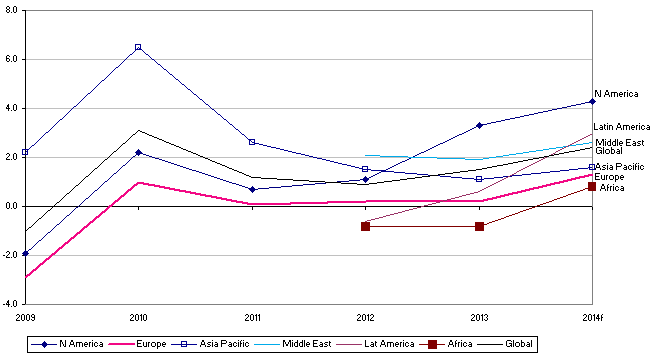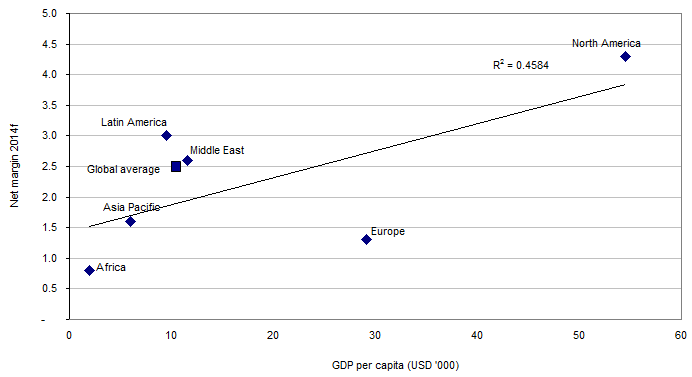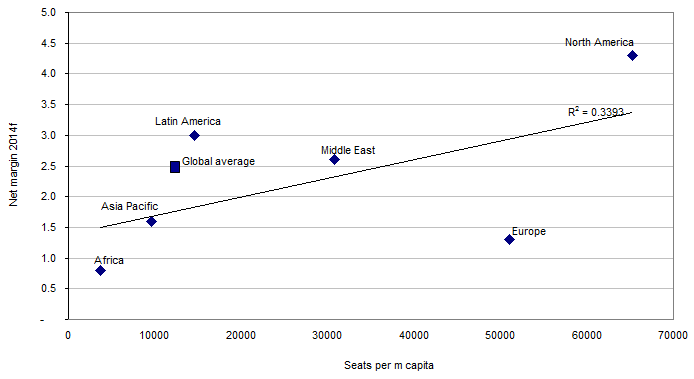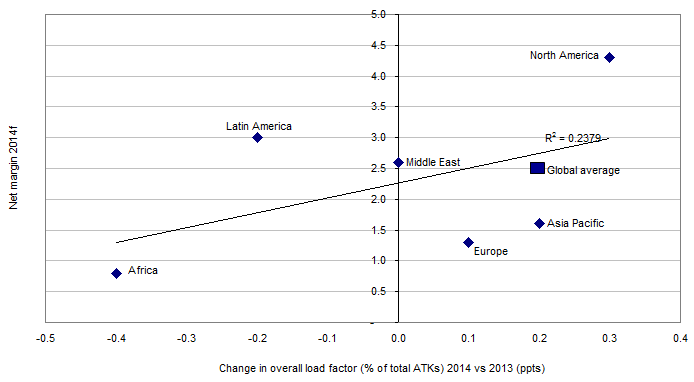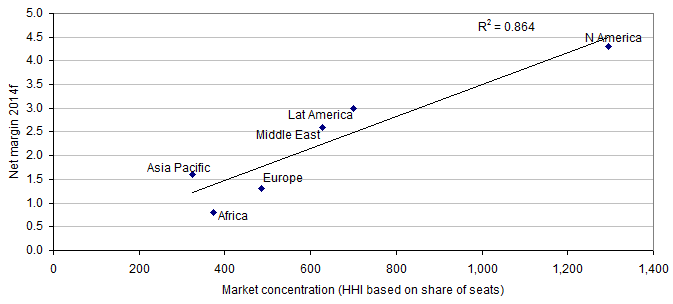Airline consolidation: could Europe follow North America's path to improved margins?
IATA's latest airline industry financial forecasts highlight the different performance of the different regions of the world. North America is the most profitable region, measured by its net margin (net profit as a percentage of revenues) and Africa the least profitable. Europe has the second lowest margin, but has gained a little on fourth ranked Asia Pacific. Latin America has improved the most since 2012 to rank second, just ahead of the Middle East.
North America has had a relatively good recovery, while Asia Pacific's margins have fallen from their 2010 peak. Even North America's net profit is only 4.3% of revenues, its best since the late 1990s, but still a very thin margin.
Analysis of the relationship between net profit margins and various explanatory factors appears to confirm that market concentration is a key one. Europe's perennial underperformance in airline margin terms - in spite of the region's wealth, high propensity for air travel and high load factors - owes much to the fragmented nature of the market. Nevertheless, a European deal that is truly transformational in terms of its market structure remains unlikely for now.
- North America is the most profitable region in the airline industry, while Africa is the least profitable.
- Europe's low profitability is attributed to low yields and high regulatory costs.
- Asia Pacific's weak margins are due to a weak cargo market and low overall yields.
- Latin America has shown the most improvement in profitability since 2012.
- Market concentration is a key factor in explaining regional net margins, with Europe's low market concentration contributing to its low margins.
- Consolidation and acquisitions are expected to drive further consolidation in the European airline industry, with non-European airlines potentially playing a significant role.
Many reasons for different regional margins
The reasons given by IATA for the different levels of profitability in the different regions are varied. North America's improvement has been driven by consolidation, which has been good for load factors, and also by the development of ancillary revenues compensating for weak fares. Europe's woes are attributed to low yields (the result of the very competitive liberalised aviation market) and what IATA calls "high regulatory costs".
Asia Pacific continues to suffer from a weak cargo market, although there has been some improvement here and this is helping to push forecast margins up in 2014. The Middle East enjoys relatively low unit costs, helping to offset low yields, both linked to strong forecast capacity growth of 13% in 2014.
IATA characterises the performance of Latin America as "mixed", with weak domestic markets and some long-haul "success", although profit growth is being helped by consolidation.
Africa remains the weakest region, although it is forecast to return to a positive net result in 2014, as load factors are the lowest in the world.
Net profit margins* by region: 2013 and 2014F
|
|
2013 |
2014F |
|
N America |
3.3 |
4.3 |
|
Lat America |
0.6 |
3.0 |
|
1.9 |
2.6 |
|
|
1.1 |
1.6 |
|
|
0.2 |
1.3 |
|
|
-0.8 |
0.8 |
|
|
Global |
1.5 |
2.4 |
Net profit margins* by region: 2009 to 2014F
In a recent report, CAPA analysed the well-established link between the penetration of air travel of a nation or region (expressed as airline seats per capita) and its wealth (expressed by GDP per capita).
See related report: Air travel rises with a country's wealth. Law of nature, or can government policy make a difference?
IATA's regional forecasts for 2014 now lead us to consider whether net margins might be correlated to these factors for the regions of the world. We will also consider the relationship between net margins and other factors. Clearly, margins are a function of many variables and the relationship with these variables will change through the cycle. Nevertheless, with the airline cycle in an upswing, it can be informative to examine some of these relationships.
Is net margin linked to GDP per capita?
The chart below shows a scatter plot of 2014F net margins versus GDP per capita for the regions of the world. It shows that there is a reasonably good correlation between the two, particularly if Europe were removed from the chart (the R squared, which indicates the closeness of the relationship, would improve from 0.46 to 0.74).
This seems to suggest that airlines are more profitable in wealthier regions, possibly because the discretionary spend element of air travel increases and this helps unit revenues (although unit costs are typically also higher in developed markets, mainly due to higher labour costs).
Although we have chosen a straight line as the trend line on this chart, the data points, if Europe is excluded, suggest a curve that rises from left to right, but flattens off as GDP per capita increases. Europe stands out as having a much lower margin than it should have, given its level of GDP per capita.
Net profit margin 2014F versus GDP per capita
....Or airline seats per capita?
The following chart shows 2014F net margins versus airline seats per capita by region, with similar results to those of the previous chart and a fair correlation. It appears that, broadly, profitability is higher in regions with a higher penetration of air travel.
This seems reasonably intuitive: a high number of airline seats per head of population implies both a high level of per capita spend on air travel and a more efficient use of aviation assets. Again, Europe stands out as being a serious laggard.
Net profit margin 2014F versus airline seats per capita
Does weight load factor have an impact?
IATA's Jun-2014 financial forecasts include regional figures for overall load factor (or weight load factor), which is defined as total revenue tonne kilometres as a percentage of total available tonne kilometres (ie including both passenger and cargo traffic).
A positive correlation between net margin and overall load factor might be expected: filling up an aircraft generates more revenues and makes more efficient use of the asset.
However, although the trend line in the chart below slopes upwards, the R squared is so low as to suggest that there is virtually no real correlation. This seems to be mainly due to the low margins of Europe and Asia Pacific compared to their high load factors. The other regions confirm the positive relationship between load factor and margin, but the margins of Europe and Asia Pacific are apparently being held back by other factors.
Not for the first time, Europe is an underperformer, this time joined by Asia Pacific.
Net profit margin 2014F versus overall load factor* 2014F
Our expectation that overall load factor must have something to do with profitability is better confirmed by a plot of margins against change in load factor from 20013 to 2014F (see chart below).
Here, the R squared improves to 0.24, but this is still not very high. Indeed, Latin America is forecast to be enjoying a relatively high margin, compared with other regions, but it is forecast to suffer a decline in load factor. Europe and Asia Pacific again stand out as underperformers on this chart.
Net profit margin 2014F versus change in overall load factor* 2014F versus 2013
We can explain North America's strong margins and (mostly) why Asia Pacific is weaker
Focusing on the three biggest aviation markets, the factors examined above are most helpful in explaining the net margins of North America, which is performing at the top end on most of them.
Asia Pacific's net margin is roughly where it might be expected to be when looking at GDP per capita and airline seats per capita, but it is below expectation when looking at overall load factor.
This may be because of the relative importance of cargo to Asia Pacific airlines. They are achieving the highest overall load factors, which take account of both passenger and cargo traffic, but the weakness of the cargo market means that these high load factors are at the expense of low overall yields and overall unit revenues are low.
There's something else holding back Europe…
Europe's margin is below where it might be expected to be when looking at all the above measures. Its low profitability cannot be explained by GDP per capita, seats per capita, or overall load factor, all of which are relatively high in Europe.
These factors are quite good at explaining the relative margins of the other regions (with the exception of Asia Pacific and load factor, as already mentioned), but there is something else holding back Europe's profit margins.
The answer may lie in a factor that we analysed in May-2013. At that time, we suggested that market concentration may be an important factor in explaining profitability and, now using updated numbers, our current analysis supports this suggestion.
See related report: European airline consolidation to enhance financials? Few deals to be done, at least locally
… low market concentration
As a measure of market concentration, we use the Herfindahl-Hirschman Index (HHI). The HHI is calculated by squaring the percentage market share of each firm in the market and summing these numbers. The index would be 10,000 if a market were a pure monopoly (100 squared). The lower the index the more competitive the market, while a high number indicates market concentration and possible monopoly power.
We calculate a HHI for each of the world regions, using the share of seats for each airline group in each region. In the UK, Office of Fair Trading/Competition Commission merger guidelines suggest that a market with an HHI of more than 2,000 can be characterised as highly concentrated, a level not reached by the airline market in any region.
The chart below is a scatter plot of 2014F net margins against the seat share-based Herfindahl-Hirschman Index for each global region. This produces our strongest correlation, with an R squared of 0.86, suggesting that market concentration is a far better explanatory factor of regional net margins than GDP per capita, seats per capita and overall load factor.
Moreover, Europe has a low HHI and sits not too far from the trend line on this chart. From this we can deduce that the low market concentration in Europe is an important factor in explaining its low margins.
Net profit margin 2014F versus versus Herfindahl-Hirschman Index of market concentration based on market share by seats
Europe's "highly competitive open aviation area"
IATA makes reference to the "highly competitive open aviation area", arguing that this contributes to Europe's high breakeven load factors (and, therefore, its low margins). Covering much, although not all, of Europe, this area has fully liberalised market access and ownership and control in respect of airlines that are based within its borders.
This liberalisation, which took full effect in the 1990s, first stimulated new entrants and increased competition and then led to a consolidation phase. However, since airlines from outside the zone do not have the same market access and may not control airlines from within the zone, this consolidation process has been limited to those that are inside it.
Beyond the top five groups by number of seats (Lufthansa, Air France-KLM, Ryanair, IAG and easyJet), the next five are Turkish Airlines, the Etihad Equity Alliance airlines (treating them all as one group, for the purposes of this exercise - a reasonable simplification, with the possible exception of Aer Lingus, in which Etihad only has a 3% stake), SAS, Aeroflot Group and Norwegian Air Shuttle.
The share of seats of those ranked number six to number 10 ranges from 5% down to 3%. The only others with a share of more than 1% of seats are Alitalia and Pegasus, ranked 11 and 12 respectively.
Top 12 Airline Groups in Europe, ranked by seats: 2-Jun-2014 to 8-Jun-2014
|
Rank |
Airline Group |
Share of total seats in Europe |
|
1 |
11% |
|
|
2 |
8% |
|
|
3 |
8% |
|
|
4 |
8% |
|
|
5 |
6% |
|
|
6 |
5% |
|
|
7 |
5% |
|
|
8 |
4% |
|
|
9 |
3% |
|
|
10 |
3% |
|
|
11 |
2% |
|
|
12 |
2% |
Where might a transformational European merger/acquisition come from?
Whereas AMR Corp's acquisition of US Airways took its share of seats in North America from around 14% to more than 20% for the new American Airlines Group, there is no such significant transaction that is obviously likely or possible in Europe.
Out of the top five in Europe, the two LCCs (Ryanair and easyJet) are unlikely to make big acquisitions, although their growth has led to organic market share gains and this (slower process of) consolidation is likely to continue. The Big Three legacy groups, Lufthansa, IAG and Air France-KLM are all still either integrating acquisitions or undergoing other significant restructuring and it seems unlikely that a big acquisition is imminent for any of them for now.
Moreover, even if any of the Big Three did want to make an acquisition in Europe, most of the groups ranked six to 12 are outside the European Common Aviation Zone. This would present a major challenge due to the limits on foreign ownership and control in the countries where those airline groups are based. In addition, the previous apparent drawing near of Lufthansa and Turkish Airlines has since cooled.
SAS may now be a more likely target than before
Of the others with more than a 1% share of seats in Europe, only SAS, Norwegian and Alitalia are inside the liberalised zone. SAS has made some improvements in its profitability and this may now be the most likely target from these three for acquisition by another European group, with Lufthansa probably the most likely acquirer (although this is not an agenda-topping item for the German group).
A merger between Norwegian and SAS remains unlikely, but perhaps possible at some point, and Norwegian is otherwise an unlikely target itself for either the Big Three or another LCC. Alitalia is reportedly on the verge of joining the Etihad Equity Alliance and is now unlikely to be acquired by another European group.
RyanWizz?
Deals involving targets outside this top 12 or 13 would have only a minimal impact on market concentration, but one possibility that would nevertheless attract attention raises its head.
Just outside our top 12 list lies ultra-LCC Wizz Air, with a share of around 1% of seats in Europe. Last year, we suggested that an acquisition of Wizz Air by Ryanair would not be unimaginable, although we called this an outlier on the probability scale. With Wizz Air now planning a stock exchange listing, it might be slightly less of an outlier. Given Ryanair's surprise raid on Aer Lingus shares just days after the latter's flotation in 2006, might it be tempted to try the same trick on Wizz Air?
See related report: Wizz Air: London share listing planned after three-fold profit increase for the ultra-LCC
Could Europe's legacy Big Three become the Big Two, or will non-Europeans be the main force for consolidation?
A deal involving two of the Big Three legacy groups would be far more significant in increasing market concentration than any of these smaller possible transactions. They all still have other priorities and would no doubt face political, labour and competition-related obstacles if any of them did try to make such a move.
Nevertheless, such a transaction looks necessary at some point if Europe's airline industry is to gain the margin benefits of consolidation more rapidly than by the slower process of market share gains by larger players and market exit by smaller players. If the industry remains in its current cyclical upswing, perhaps a window of opportunity may open up over the next year or two (a subject perhaps worthy of further analysis).
Meanwhile, it may be that Etihad (and other non-European airlines, such as Korean Air, which has a 44% stake in CSA Czech) may now be the most effective force for consolidation in Europe, albeit in a manner that is less watertight than outright acquisition.
See related report: Airline ownership & control. Why might Europe uphold something its officials call "stupid"?
